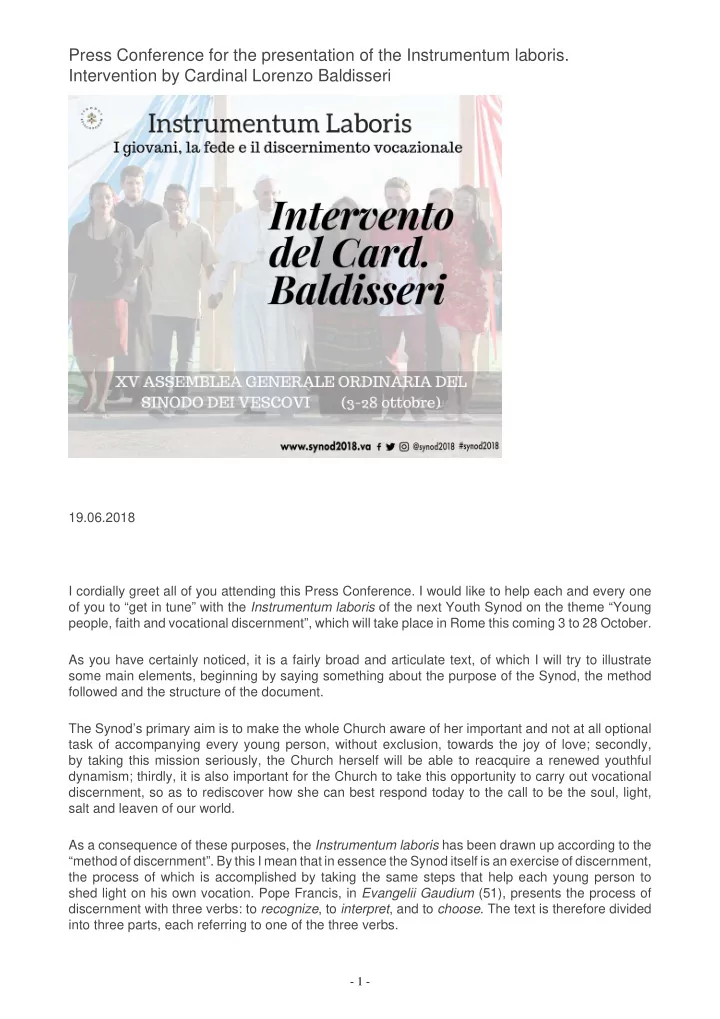

Press Conference for the presentation of the Instrumentum laboris. Intervention by Cardinal Lorenzo Baldisseri 19.06.2018 I cordially greet all of you attending this Press Conference. I would like to help each and every one of you to “get in tune” with the Instrumentum laboris of the next Youth Synod on the theme “Young people, faith and vocational discernment”, which will take place in Rome this coming 3 to 28 October. As you have certainly noticed, it is a fairly broad and articulate text, of which I will try to illustrate some main elements, beginning by saying something about the purpose of the Synod, the method followed and the structure of the document. The Synod’s primary aim is to make the whole Church aware of her important and not at all optional task of accompanying every young person, without exclusion, towards the joy of love; secondly, by taking this mission seriously, the Church herself will be able to reacquire a renewed youthful dynamism; thirdly, it is also important for the Church to take this opportunity to carry out vocational discernment, so as to rediscover how she can best respond today to the call to be the soul, light, salt and leaven of our world. As a consequence of these purposes, the Instrumentum laboris has been drawn up according to the “method of discernment”. By this I mean that in essence the Synod itself is an exercise of discernment, the process of which is accomplished by taking the same steps that help each young person to shed light on his own vocation. Pope Francis, in Evangelii Gaudium (51), presents the process of discernment with three verbs: to recognize , to interpret , and to choose . The text is therefore divided into three parts, each referring to one of the three verbs. - 1 -
The first phase of discernment is marked by the verb “to recognize ”. There immediately comes to mind the story of the episode of Emmaus, where it is said that “their eyes were opened and they recognized Him” ( Lk 24: 31). It is therefore evident that “to recognize” is not a generic seeing or listening, but rather much more: it is about letting oneself be inhabited by the grace of having the disciple’s outlook, an understanding of reality that knows how to see the heart, an intelligence that arises from the viscera of mercy that dwell in every one of us. “To recognize” means to participate in God’s gaze upon reality, observing the way in which God speaks to us through this. The second phase relates to the verb “to interpret ”. Reality is more important than the idea, but ideas become necessary when the appeals that come from reality are recognized. A frame of reference is needed to interpret reality, otherwise we remain prey to superficiality. It is necessary to examine in depth, towards a biblical and anthropological, theological and ecclesiological, pedagogical and spiritual level. Good ideas illuminate, clarify, untie knots, help untangle the skein, overcome confusion and resolve fragmentation, accompanying an integral and symphonic vision. The third moment focuses on the need to choose . After recognizing and interpreting, the most delicate and important phase is to make courageous and far-sighted decisions in light of the path taken. Discernment too often threatens to run aground as a result of endless analyzes and many different interpretations, which do not come to fruition, that is, they do not reach concrete, prophetic and practical decisions. Here it becomes important to complete the journey through shared choices that help us in our journey of pastoral and missionary conversion. Content It is impossible to shed light on the full contents of the Instrumentum laboris here. I will briefly consider some, passing through the document in a linear fashion. The fundamental choices that guided its compilation will also emerge. 1.1 First part: “Recognizing: the Church listening to reality” After having clarified in the introduction the purposes, the method and the structure, the first part is composed of five chapters. The first two offer a rather broad view of the different contexts, showing that there are indeed many differences and many commonalities among young people around the world: globalization creates a lot of homologation, but nevertheless many social, economic, cultural, religious and spiritual differences remain. Among the various concerns that are indicated, I emphasize the theme of intergenerational relationships - which see adults tendentially in competition rather than in alliance with young people - and the now overriding presence of the digital continent, which is an unprecedented platform of life for young people with important opportunities and new dangers. Three chapters then follow, which define three specific focuses on specific issues. The magnifying glass is first turned on the poorest and most abandoned young people, who are continually rejected by a world that understands itself starting from the paradigm of rejection, of “buy, use, and discard”. When this “culture” is applied to human persons, any consideration of their dignity is lost: work (both from the point of view of its absence and that of exploitation), migration, discrimination and social exclusion offer sad examples. The second magnifying glass - the fourth chapter - offers a deeper reading of six “anthropological and cultural challenges” that the Church is called to face today in her pastoral commitment to young people: the new understanding of the body, of affectivity and of sexuality; the advent of new cognitive paradigms that convey a different approach to the truth; the anthropological affects of the digital - 2 -
Recommend
More recommend